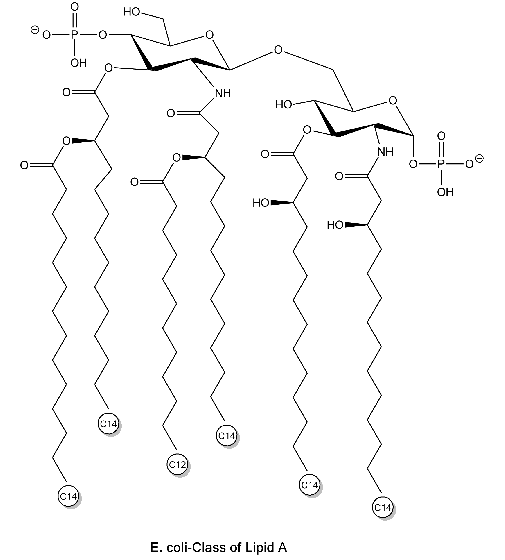Lipid A from E. coli R515 (Re) TLRpure Sterile Solution
No additional charges, what you see is what you pay! *
| Code | Size | Price |
|---|
| IAX-100-004-C250 | 250 ug | £113.00 |
Quantity:
| IAX-100-004-C500 | 500 ug | £172.00 |
Quantity:
| IAX-100-004-M001 | 1 mg | £296.00 |
Quantity:
Prices exclude any Taxes / VAT
Stay in control of your spending. These prices have no additional charges to UK mainland customers, not even shipping!
* Rare exceptions are clearly labelled (only 0.14% of items!).
* Rare exceptions are clearly labelled (only 0.14% of items!).
Multibuy discounts available! Contact us to find what you can save.
This product comes from: Switzerland.
Typical lead time: 7-10 working days.
Contact us for more accurate information.
Typical lead time: 7-10 working days.
Contact us for more accurate information.
- Further Information
- Documents
- References
- Related Products
- Show All
Further Information
Alternate Names/Synonyms:
Lipid A derived from E. coli R515 (Re) LPS (biosynthetic)
Biological Activity:
Optimal concentration is dependent upon cell type, species, desired activation and analysis: 0.1-1.0µg/ml. Does not activate any TLR other than TLR4 as tested up to 50µg/ml in relevant cellular systems (macrophages).
Concentration:
1mg/ml (0.5mg/ml for 250µg size) stabilised in sterile, double-distilled water (ddWater), without any additives.
EClass:
32160000
Form (Short):
liquid
Formulation:
Liquid. Colourless opaque aqueous solution.
GHS Symbol:
GHS07
Handling Advice:
Do not freeze.Ready-made solution is cell culture-grade. Prepare diluted Lipid A working solutions in water just prior to use, keep sterile.To yield a 100µg/ml (1,000-100x) stock solution add 100µl of Lipid A to 900µl endotoxin-free and sterile ddWater (Cat. No.: IAX-900-002) (not PBS) and mix well.
Hazards:
H302, H312, H332
Long Description:
Chemical. Isolated and purified from E. coli strain R515. Activation of cells by LPS is mediated by the Toll-like receptor 4 (TLR4), a member of the highly conserved protein family of TLRs, which are specialised in the recognition of microbial components. In mice, defects in TLR4 result in LPS unresponsiveness. For optimal interaction with LPS, TLR4 requires association with myeloid differentiation protein 2 (MD-2). According to current consensus activation of TLR4 is preceded by the transfer of LPS to membrane-bound (m) or soluble (s) CD14 by LPS-binding protein (LBP). This mechanism is believed to be generally true for LPS signaling. Re-form LPS and lipid A, but not S-form LPS, are capable of inducing TNF-alpha responses also in the absence of CD14. LPS, synthesized by most wild-type (WT) Gram-negative bacteria (S-form LPS), consists of three regions, the O-polysaccharide chain, which is made up of repeating oligosaccharide units, the core oligosaccharide and the lipid A, which harbors the endotoxic activity of the entire molecule. R-form LPS synthesized by the so-called rough (R) mutants of Gram-negative bacteria lacks the O-specific chain. Furthermore, the core-oligosaccharide may be present in different degrees of completion, depending on the class (Ra to Re) to which the mutant belongs. Monophosphoryl Lipid A (MPLA) represents a detoxified derivative of Lipid A and constitutes an important adjuvant in prophylactic and therapeutic vaccines.
Other data:
TLRpure™: • Qualified Purity & Activity • High potency TLR4-specific Ligands • Ultrapure (no detectable protein, RNA and DNA) • Tested on TLR4 KO murine macrophages • Standardised Aqueous Sterile Solutions • No purification or hazardous solubilisation • Excellent lot-to-lot consistency
Package Type:
Glass Vial
Precautions:
P261, P301, P312, P302, P352, P304, P340
Product Description:
Activation of cells by LPS is mediated by the Toll-like receptor 4 (TLR4), a member of the highly conserved protein family of TLRs, which are specialised in the recognition of microbial components. In mice, defects in TLR4 result in LPS unresponsiveness. For optimal interaction with LPS, TLR4 requires association with myeloid differentiation protein 2 (MD-2). According to current consensus activation of TLR4 is preceded by the transfer of LPS to membrane-bound (m) or soluble (s) CD14 by LPS-binding protein (LBP). This mechanism is believed to be generally true for LPS signaling. Re-form LPS and lipid A, but not S-form LPS, are capable of inducing TNF-alpha responses also in the absence of CD14. LPS, synthesized by most wild-type (WT) Gram-negative bacteria (S-form LPS), consists of three regions, the O-polysaccharide chain, which is made up of repeating oligosaccharide units, the core oligosaccharide and the lipid A, which harbors the endotoxic activity of the entire molecule. R-form LPS synthesized by the so-called rough (R) mutants of Gram-negative bacteria lacks the O-specific chain. Furthermore, the core-oligosaccharide may be present in different degrees of completion, depending on the class (Ra to Re) to which the mutant belongs. Monophosphoryl Lipid A (MPLA) represents a detoxified derivative of Lipid A and constitutes an important adjuvant in prophylactic and therapeutic vaccines.
Purity:
>99.9%. No detectable DNA, RNA and protein traces.
Signal word:
Warning
Source / Host:
Isolated and purified from E. coli strain R515.
Transportation:
Non-hazardous
UNSPSC Category:
Lipopolysaccharides
UNSPSC Number:
12352200
Use & Stability:
Stable for at least 2 years after receipt when stored at +4°C.
Documents
References
A new method for the extraction of R lipopolysaccharides: C. Galanos, et al.; Eur. J. Biochem. 9, 245 (1969) | Preparation and properties of antisera against the lipid-A component of bacterial lipopolysaccharides: C. Galanos, et al.; Eur. J. Biochem. 24, 116 (1971) | Endotoxic properties of chemically synthesized lipid A part structures. Comparison of synthetic lipid A precursor and synthetic analogues with biosynthetic lipid A precursor and free lipid A: C. Galanos, et al.; Eur. J. Biochem. 140, 221 (1984) | Lipopolysaccharides: structural principles and biologic activities: O. Luederitz, et al.; Rev. Infect. Dis. 6, 428 (1984) | Synthetic and natural Escherichia coli free lipid A express identical endotoxic activities: C. Galanos, et al.; Eur. J. Biochem. 148, 1 (1985)
Related Products
| Product Name | Product Code | Supplier |
|---|



